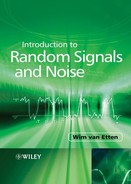Contents
1.3 The Concept of a Stochastic Process
1.3.1 Continuous Stochastic Processes
1.3.2 Discrete-Time Processes (Continuous Random Sequences)
1.3.3 Discrete Stochastic Processes
1.3.4 Discrete Random Sequences
1.3.5 Deterministic Function versus Stochastic Process
2.1.1 Cumulative Distribution Function and Probability Density Function
2.1.2 First-Order Stationary Processes
2.1.3 Second-Order Stationary Processes
2.1.4 Nth-Order Stationary Processes
2.2.1 The Autocorrelation Function, Wide-Sense Stationary Processes and Ergodic Processes
2.2.2 Cyclo-Stationary Processes
2.2.3 The Cross-Correlation Function
2.2.4 Measuring Correlation Functions
2.2.6 Physical Interpretation of Process Parameters
2.5.1 Mean, Correlation Functions and Covariance Functions
3 Spectra of Stochastic Processes
3.2 The Bandwidth of a Stochastic Process
3.4 Modulation of Stochastic Processes
3.4.1 Modulation by a Random Carrier
3.5 Sampling and Analogue-To-Digital Conversion
3.6 Spectrum of Discrete-Time Processes
4. Linear Filtering of Stochastic Processes
4.1 Basics of Linear Time-Invariant Filtering
4.2 Time Domain Description of Filtering of Stochastic Processes
4.2.1 The Mean Value of the Filter Output
4.2.2 The Autocorrelations Function of the Output
4.2.3 Cross-Correlation of the Input and Output
4.3 Spectra of the Filter Output
4.4.1 Band-Limited Processes and Systems
4.4.2 Equivalent Noise Bandwidth
4.5 Spectrum of a Random Data Signal
4.6 Principles of Discrete-Time Signals and Systems
4.6.1 The Discrete Fourier Transform
4.7 Discrete-Time Filtering of Random Sequences
4.7.1 Time Domain Description of the Filtering
4.7.2 Frequency Domain Description of the Filtering
5.1 Description of Deterministic Bandpass Signals
5.2 Quadrature Components of Bandpass Processes
5.3 Probability Density Functions of the Envelope and Phase of Bandpass Noise
5.4.2 Measurement of the Quadrature Components
5.5 Sampling of Bandpass Processes
6 Noise in Networks and Systems
6.2 Thermal Noise in Resistors
6.3 Thermal Noise in Passive Networks
6.4.3 Noise in Cascaded systems
7 Detection and Optimal Filtering
7.1.2 Detection of Binary Signals in White Gaussian Noise
7.1.3 Detection of M-ary Signals in White Gaussian Noise
7.2 Filters that Maximize the Signal-to-Noise Ratio
7.4 Filters that Minimize the Mean-Squared Error
7.4.1 The Wiener Filter Problem
7.4.4 Discrete-Time Wiener Filtering
8 Poisson Processes and Shot Noise
8.2.1 The Characteristic Function
8.2.3 Interarrival Time and Waiting Time
8.3 The Homogeneous Poisson Process
8.3.1 Filtering of Homogeneous Poisson Processes and Shot Noise
8.4 Inhomogeneous Poisson Processes
Appendices
A. Representation of Signals in a Signal Space
A.3 Gram-Schmidt Orthogonalization
A.4 The Representation of Noise in Signal Space
A.4.1 Relevant and Irrelevant Noise
A.5.1 Binary Antipodal Signals
A.5.2 Binary Orthogonal Signals
A.5.6 M-ary Orthogonal Signals
B. Attenuation, Phase Shift and Decibels
C.2.1 Rules fn Differentiation
C.3.3 Rational Algebraic Functions
D. Summary of Probability Theory
E. Definition of a Few Special Functions
